Cu-Mo çöktürülmüş karbon keçe elektrotların hazırlanması, karakterizasyonu ve hidrojen gazı üretimine katalitik etkilerinin incelenmesi
Özet
Bu çalışmada elektroliz sistemindeki aşırı gerilimleri düşürmek ve hidrojen gazı oluşum
reaksiyonunu hızını artırmak için büyük yüzey alanına sahip karbon keçenin (C) yüzeyi
farklı akımlar uygulanarak farklı miktarlarda Cu ve Mo çöktürülmüştür (C/Cu, C/Mo).
Belirlenen uygun çöktürme akımı ve metal miktarında Mo ve Cu farklı oranlarda
çöktürülerek elektrotun katalitik etkisi daha da arttırılmaya çalışılmıştır. Elektrotların
yüzey yapıları taramalı elektron mikroskopu (SEM) ile incelenmiş, elektrot yüzeylerinin
kimyasal bileşimleri ise enerji dağılımlı X-ray spektroskopisi (EDX) ile belirlenmiştir.
Hazırlanan elektrotlar katot olarak kullanılmış ve 1 M KOH çözeltisinde hidrojen gazı
üretimine katalitik etkileri incelenmiştir. Bu amaçla, katodik akım-potansiyel eğrileri ve
elektrokimyasal impedans spektroskopisi teknikleri kullanılmıştır. Elde edilen sonuçlara
göre Mo ve Cu metallerinin C yüzeyine çöktürülmesi elektrotun hidrojen gazı üretimine
katalitik etkisini arttırmaktadır. C yüzeyine Mo ve Cu bir arada çöktürüldüğünde
elektrotun katalitik etkisi daha da artmaktadır. MoCu ikili katalizörlerin katalitik etkisi
çöktürülen metal oranlarına bağlı olup çalışılan koşullarda en etkin elektrot çöktürme
banyosunda Mo ve Cu mol oranının 1:0,1 olduğu (*C/MoCu-5) koşullarda elde
edilmiştir. Bu elektrot (*C/MoCu-5) elektroliz sisteminde katot olarak kullanıldığında
elektrotun hidrojen oluşumuna katalitik etkisi zamanla hemen hemen sabit kalmıştır. In this study, Mo and Cu metals with various amounts at different deposition currents
were electrochemically deposited over a carbon felt (C) which has high surface area
(C/Cu, C/Mo) in order to reduce overpotentials in electrolysis system and increase the
rate of hydrogen evolution reaction. In order to enhance catalytic effect of the electrode,
MoCu binary coatings with various metal ratios were prepared over the C felt electrode
(C/MoCu) at the determined optimum deposition current and total metal amounts. The
surface morphologies were investigated by scanning electron microscopy (SEM), and the
chemical composition of the surfaces were determined by energy dispersive X-ray
spectroscopy (EDX). The prepared electrodes were used as cathode, and their catalytic
activities for hydrogen gas production were investigated in 1 M KOH solution. For this
aim, cathodic current-potential and electrochemical impedance spectroscopy
measurements were performed. The data obtained showed that, the deposition of Cu and
Mo over the C enhances the hydrogen evolution activity of the electrode. The codeposition
of small amount of Mo and Cu could further enhance hydrogen evolution
activity of the electrode. The electrocatalytic activity of the binary CoMo catalysts
depends on metal ratios of the deposited metals. The *C/MoCu-5 electrode with 1:0.1
(Mo:Cu) metal ratio in the bath solution has the highest hydrogen evolution activity
among the studied electrodes. The catalytic activity of this electrode (*C/MoCu-5) nearly
remained the same, when this electrode was used in electrolysis system as cathode.
Bağlantı
http://hdl.handle.net/11472/467Koleksiyonlar
- Kimya [60]

DSpace@BİNGÖL by Bingöl University Institutional Repository is licensed under a Creative Commons Attribution-NonCommercial-NoDerivs 4.0 Unported License..













